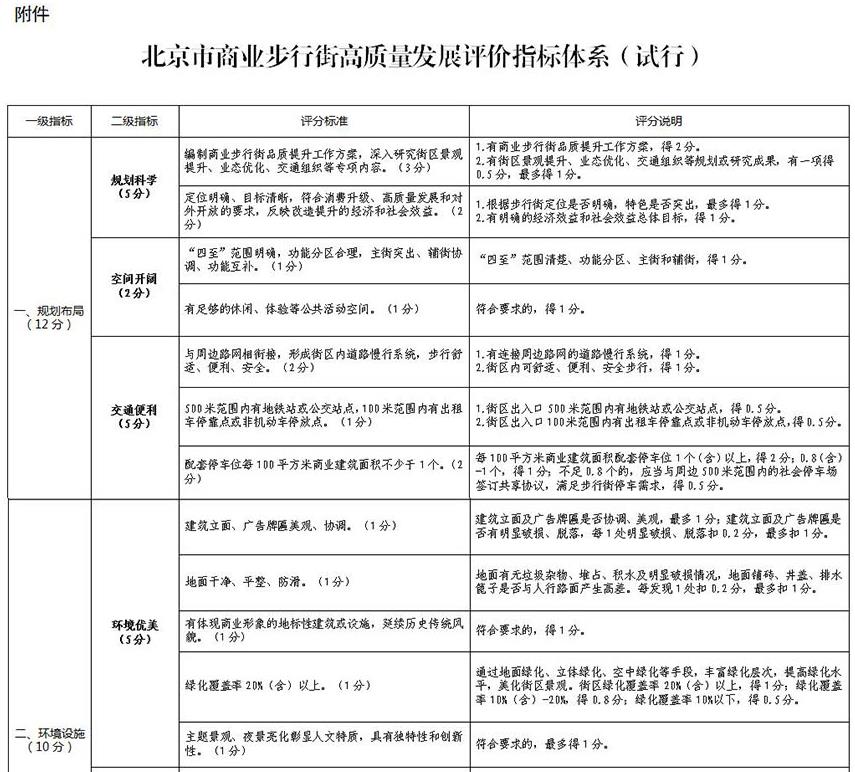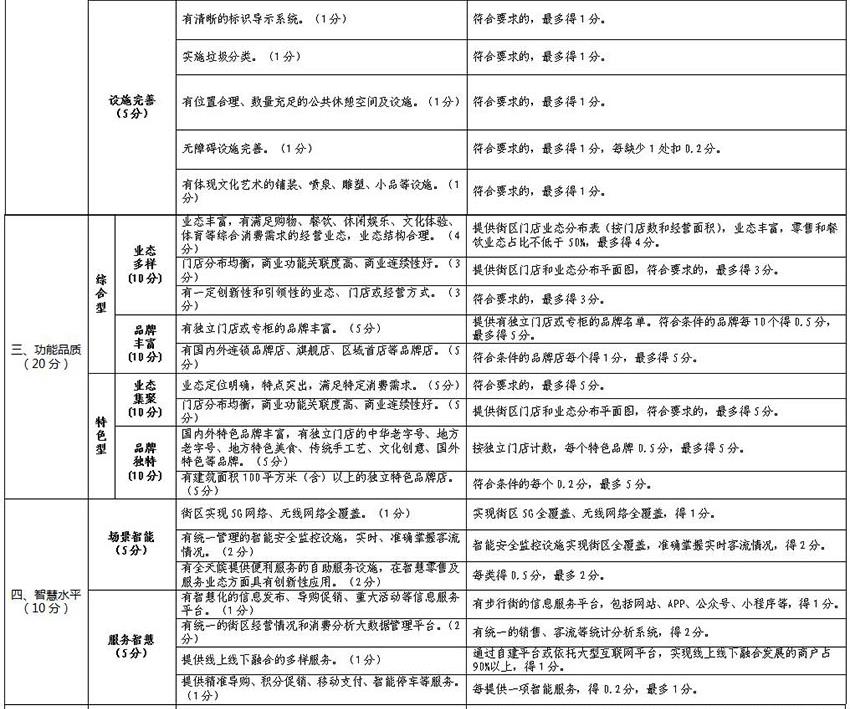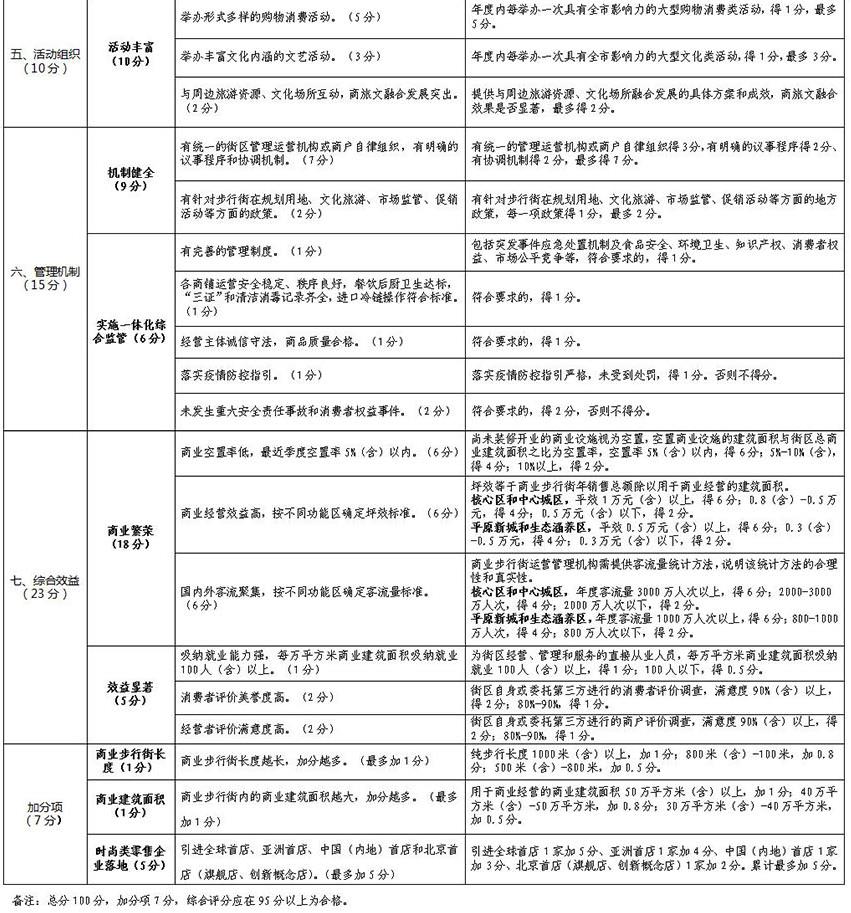Jing Shang Gui Zi [2022] No.11
Bureau of Commerce of each district and Bureau of Commerce and Finance of Beijing Economic and Technological Development Zone:
In order to implement the requirement of "Beijing’s Implementation Plan for Cultivating and Building an International Consumer Center City (2021-2025)" that "by 2025, there will be at least one commercial pedestrian street in each district" and create a commercial pedestrian street with characteristics, quality, digitalization and cultural heritage, the Municipal Bureau of Commerce has studied and formulated the Guiding Opinions on Promoting the High-quality Development of Commercial Pedestrian Street in Beijing, which is hereby printed and distributed to you. Please conscientiously implement it in light of the actual situation.
I hereby inform you.
Beijing Municipal Bureau of Commerce
November 30, 2022
Guiding Opinions of Beijing Municipality on Promoting the High-quality Development of Commercial Pedestrian Street
In accordance with the decision-making arrangements of the Municipal Party Committee and the Municipal Government, in order to implement the Implementation Plan for Cultivating and Building an International Consumer Center City in Beijing (2021-2025) and accelerate the high-quality development of commercial pedestrian streets, the following opinions are put forward.
I. General requirements
(A) the definition of commercial pedestrian street
Commercial pedestrian street is an open commercial activity space with street architectural form as the main body, motor vehicles are prohibited or restricted on the ground, and commercial and service facilities are highly concentrated, which meets people’s comprehensive or professional consumption demand for commerce and fully embodies pedestrians’ priority, including strip commercial pedestrian street and block commercial pedestrian street. According to the vehicle ban, it can be divided into full-time and time-sharing commercial pedestrian streets. According to the functional orientation, it can be divided into comprehensive and characteristic commercial pedestrian streets.
(2) Basic principles
1. Government guidance and market dominance. On the basis of strictly implementing the general rules and zoning planning, and extensively listening to the opinions of market participants and all sectors of society, the municipal and district governments should do a good job in planning and guiding, clarify the development orientation of commercial pedestrian streets, provide policy support in terms of renovation, business upgrading, project approval, and provide service guarantee in terms of market supervision, traffic organization, environmental improvement, and intelligent construction. It is necessary to fully understand that market players are the main force in the transformation and upgrading of commercial pedestrian streets, and support them to participate in planning, construction, management and operation in improving overall quality, introducing commercial brands, creating consumption atmosphere and improving service quality.
2. Scientific planning and overall development. Guide the high-quality development of commercial pedestrian street with high-standard planning, and avoid blind development and longer construction of commercial pedestrian street. Identify their own advantages, optimize the neighborhood environment, improve the quality of business, build smart neighborhoods, standardize management and operation, focus on improving the level of convenience and comfort, form a distinctive development pattern, and effectively improve people’s sense of acquisition and happiness.
3. Based on the stock, transform and upgrade. Adhere to the economic development stage and objective reality, combined with the development status of commercial pedestrian streets, each district chooses the existing commercial pedestrian streets with good foundation and great potential for transformation and upgrading, or based on the current commercial streets, upgrade them into commercial pedestrian streets through transformation, further supplement the shortcomings and strengths, and do not engage in large-scale demolition and construction, and do not engage in image projects.
4. Respect for culture and distinctive features. Dig deep into cultural connotation, highlight regional characteristics, pay attention to civilization inheritance and cultural continuity, and persist in protective development and utilization of historical and cultural resources. Integrate the development of commercial pedestrian street with the protection of historical and cultural heritage, and promote the integration of traditional culture into modern life.
5. Clear responsibilities and form a joint force. Establish a cross-departmental coordination mechanism with horizontal cooperation and vertical linkage, and all relevant departments at the municipal level systematically plan policy innovation and give policy support. Each district is the leading body of the quality improvement of commercial pedestrian street, responsible for the upgrading of commercial pedestrian street and the landing of new cultivation tasks.
(3) Development goals
By 2025, at least one high-quality commercial pedestrian street will be built in each district, and a number of high-quality commercial pedestrian streets with prosperous business, strong culture, distinctive features, beautiful environment and standardized governance will be built in the city.
Second, the key tasks
(A) to strengthen the planning and layout
Combined with the development status and future planning guidance requirements of the city’s commercial pedestrian streets, the city’s commercial pedestrian streets are divided into updated and upgraded types and newly cultivated types. Renewal and upgrading should focus on stock renewal, and transform and upgrade the business, environment and operation of the block; The new cultivation type should combine regional development resources and spatial structure, pay attention to the combination of planning guidance and market leadership, and cultivate commercial pedestrian streets through traffic optimization, space upgrading, business upgrading and operation upgrading.
Each district should work out a work plan for improving the quality of commercial pedestrian streets, which should be linked with the overall urban planning, zoning planning, urban renewal action and the spatial layout planning of commercial service facilities. It is necessary to highlight the main street, link auxiliary streets and coordinate development, clarify the scope, target positioning and functional layout of commercial pedestrian streets, and determine key tasks, timetables and road maps to ensure that they can land and be effective.
(2) Optimize the allocation of business formats
According to the development orientation of the block, the dynamic adjustment mechanism of the business format is established, the commercial pedestrian street and its surrounding commercial carriers are upgraded, the main street and the auxiliary street are organically connected, the commercial brands are misplaced, and the advantages are complementary, so as to build a diversified business ecosystem with high-end and public, outstanding themes and characteristics, and both fashion and trend. Comprehensive commercial pedestrian street should gather shopping, catering, culture, tourism, art, hotels and other diversified formats for integrated development, with retail and catering formats accounting for more than 50%; Characteristic commercial pedestrian street should reflect the advantages of high specialization, clustering, scale and branding, and can meet people’s specific consumption and life service needs. The scale of specialty shops with main formats accounts for more than 50% of the total operating area.
Encourage the combination of block commerce with culture, tourism, leisure, entertainment and sports consumption, and develop local specialties, handicrafts, time-honored brands and intangible cultural heritage. Support conditional neighborhoods to activate and utilize historical buildings, and introduce creative fairs, immersive performances, and historical theme exhibitions. Encourage time-honored brands to focus on traditional culture and local characteristics, develop products and services that meet the needs of modern consumption, and launch characteristic cultural and creative products with limited amount and high amount.
(3) Optimize traffic organization
When planning a commercial pedestrian street, each district should strengthen the organization and guidance of various traffic elements in and around the block, make overall consideration of vehicle access and transit needs, and scientifically design bypass schemes and road traffic rules to ensure the normal traffic of vehicles around the commercial pedestrian street, which can not only meet the travel needs of surrounding residents, but also ensure the transportation convenience of daily consumers.
The block should be equipped with a public transport system with convenient ride, strong accessibility and diverse choices. There are subway stations or bus stops within 500 meters of the block to expand the coverage of public transportation. Promote the combination of various public transport stations and commercial facilities to reduce the impact of commercial passenger flow on surrounding traffic. There are taxi parking spots and non-motor vehicle parking spots within 100 meters of the block. Integrate the parking lot resources within the block. In principle, there should be no less than one supporting parking space per 100 square meters of commercial building area. Create a safe, convenient, comfortable and high-quality slow-moving system to enhance the "walking friendliness".
(D) beautify the neighborhood environment
Each district should prepare the planning of outdoor advertising facilities and guidelines for setting plaque signs in commercial pedestrian street blocks according to law, highlight cultural characteristics and local characteristics, reflect the vitality of commercial blocks, provide creative space for operators to independently design plaque signs, and avoid homogenization of styles, colors and fonts. Historical and cultural blocks should protect the existing courtyards and continue the tradition. The building facade, materials and colors should be coordinated with the whole block style to create a characteristic block with a unique humanistic and historical atmosphere.
Each district should combine the theme orientation of the block with its own resource endowment, tailor-made characteristic signs, strengthen the impression of the block, create street interactive experience sketches and online celebrity punching points, add new landscape sketches and new node elements to traditional historical buildings, and interpret historical and cultural values in a modern form. Enrich the greening level and enhance the greening landscape. The lighting of the night scene of the block should focus on highlighting the characteristics of the block and showing the local cultural atmosphere, which should be coordinated with the commercial format and architectural style of the block. During holidays, lighting elements can be added. According to the needs of major activities, festival publicity and landscape environment layout, on the basis of implementing the concept of energy conservation and environmental protection, combined with regional features, light shows and other programs can be appropriately organized.
(5) Improve public facilities.
All districts should study and formulate management guidelines for using commercial pedestrian streets to carry out characteristic business activities, rationally plan business areas, clarify business hours and categories, and encourage enterprises that have settled in and obtained business licenses to carry out characteristic business activities within the scope of reasonable planning of their own land (land red line) by the district government.
The guide system should be designed and formulated in a unified way, and the guide system should be marked in at least two languages, and the logo should be eye-catching, clear and beautiful. At least one public rest facility shall be set every 50 meters in the block. The appearance of leisure facilities should be coordinated with the overall style of the block, integrated with the cultural elements of the block, reflecting the unique cultural characteristics of the block, and creating a pleasant and comfortable outdoor recreation and leisure space. At least one classified garbage bin or mobile cleaning vehicle shall be set up every 50 meters in the block. A complete blind road system and barrier-free service facilities should be built in the block. There should be public security alarm points, riot prevention facilities and emergency shelters in the block.
(6) Accelerate the construction of smart blocks.
Strengthen infrastructure construction to achieve full coverage of 5G networks and wireless networks. Encourage the construction of a big data platform for smart blocks, dynamically monitor the passenger flow, brand, format and business operation data of commercial pedestrian streets, timely and accurately grasp the commercial stock and operating efficiency of blocks, and provide accurate services for consumers, commercial enterprises, operating institutions and government management.
Encourage blocks to build smart business streets and smart shops, explore the use of AR/VR and other technologies, promote the popularization and application of new consumption formats, new models and new scenarios, and create smart consumption ecosystems such as navigation guide, digital landscape display, marketing service push, immersive experience, smart payment and smart parking. Use applets, apps, live broadcast platforms, multimedia interactive screens, etc., and introduce digital virtual elements to create smart consumption scenarios. Reasonably develop smart terminals such as unmanned supermarkets, unmanned shops and unmanned restaurants to realize self-help and contactless convenience consumption experience.
(VII) Innovative operation governance model.
Study and establish a co-governance mechanism and market-oriented operation mode with multi-participation of "government guidance, industry self-discipline, owner autonomy, social supervision and mass appraisal". Explore the scene of integrated comprehensive supervision, compact the responsibility of market entities, implement differentiated and accurate comprehensive supervision, implement credit supervision for commercial entities with strong management and service capabilities, and give full play to their self-management role. Encourage the establishment of commercial pedestrian street governance committees, chambers of commerce, alliances and other organizations to achieve standardized management, efficient operation and normal supervision.
Third, safeguard measures
(A) to strengthen organizational leadership
Establish a "five-level linkage" working mechanism with unified guidance of the city, overall responsibility of the district, specific management of the street, self-discipline of the social industry and standardized operation of the store. The Municipal Bureau of Commerce is responsible for coordinating and promoting the work. Municipal commerce, finance, self-regulation, transportation, urban management, market supervision, cultural tourism, fire protection, cultural relics, landscaping and other departments, establish communication and coordination mechanisms, strengthen policy innovation, regularly communicate relevant information, study and solve the difficulties and problems encountered in the development of commercial pedestrian streets, and support the construction of various districts. All districts should strengthen the implementation of responsibilities, prepare implementation plans, organize planning and construction, foster development, supervision and management.
(2) Strengthening policy support
Relevant departments at the municipal level should focus on the difficult and painful problems that restrict the development of commercial pedestrian streets, and increase policy support for transformation and upgrading and business upgrading on the premise of conforming to market rules and not breaking through the planning bottom line. Coordinate the two levels of financial funds in urban areas to support the construction of commercial pedestrian streets. The Municipal Bureau of Commerce focuses on supporting projects such as the transformation and upgrading of commercial entities, digital construction, introduction of first stores and consumption promotion activities in commercial pedestrian streets in various districts. All districts should give support to municipal supporting projects such as traffic optimization, street reconstruction, environmental beautification and landscaping of commercial pedestrian streets.
(3) Strengthen monitoring and evaluation
The Municipal Bureau of Commerce is responsible for improving the evaluation standard system of commercial pedestrian streets in the city, and jointly with relevant departments and districts, regularly carries out evaluation through self-evaluation and expert review in each district, so as to promote the construction by evaluation and realize the double promotion of economic and social benefits.
(4) Strengthen publicity and guidance.
Through the combination of traditional media and new media, policy interpretation and case analysis, we will carry out publicity from all directions, angles and channels, respond to social concerns in time, and create a good atmosphere for promoting the construction of commercial pedestrian streets.



关于作者